Business Environment Report: Dyson's Business Environment Analysis
VerifiedAdded on 2022/11/28
|22
|5144
|408
Report
AI Summary
This report provides a comprehensive analysis of the business environment, focusing on Dyson as a case study. It begins with an introduction to the business environment and its importance for businesses. Part 1 explores different organizational types (private, public, and voluntary), their structures, and the growth of the international business environment. It examines the advantages and disadvantages of interrelationships between organizational functions and their impact on organizational structure. The report then delves into the legal structures of various organizations, using Dyson, BBC, Tesco, and Oxfam as examples. Part 2 focuses on business environmental analysis, including external factors and the application of SWOT/TWOS analysis to influence decision-making. It critically evaluates the impacts of macro and micro factors on business objectives and decision-making, concluding with an overview of the key findings.
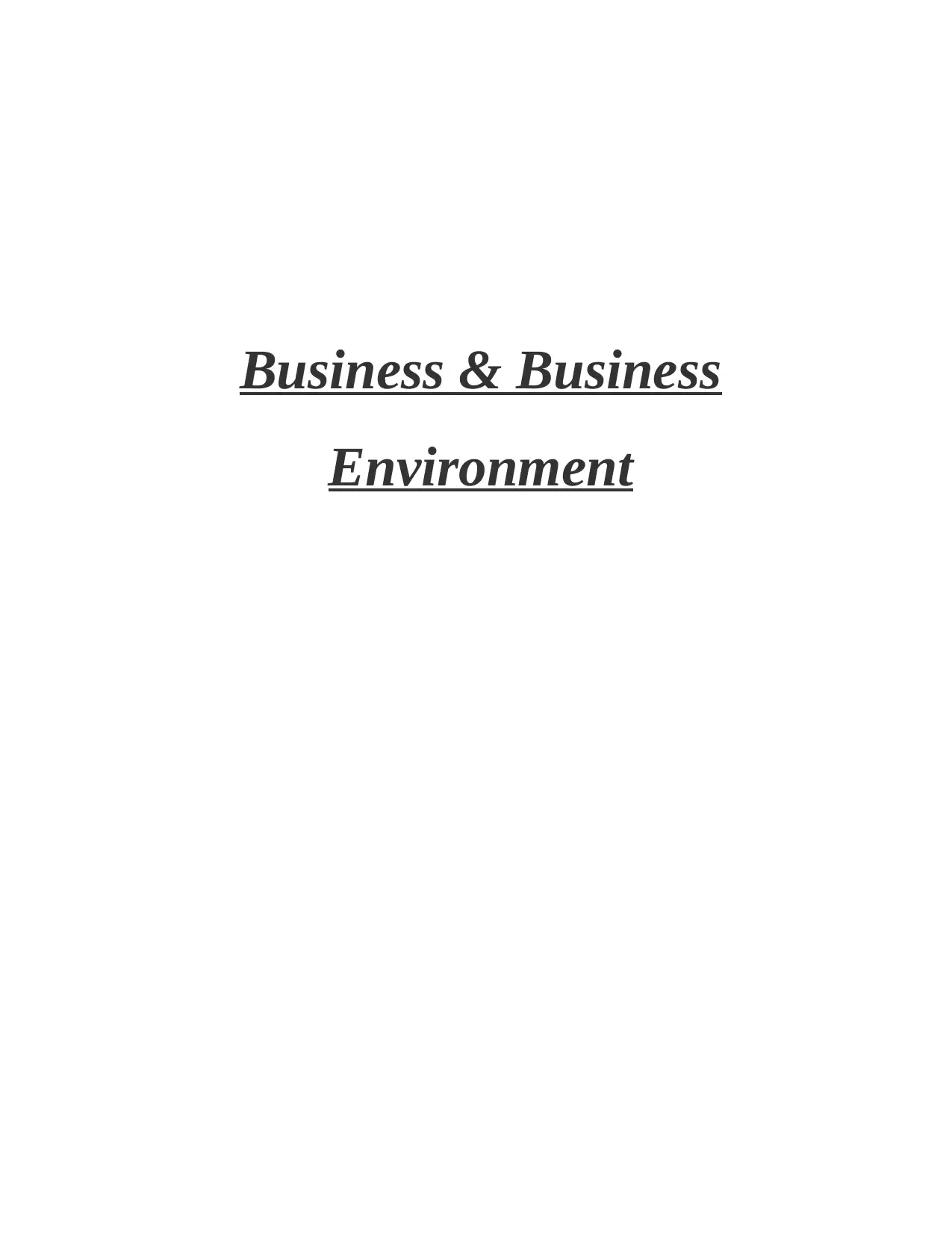
Business & Business
Environment
Environment
Paraphrase This Document
Need a fresh take? Get an instant paraphrase of this document with our AI Paraphraser
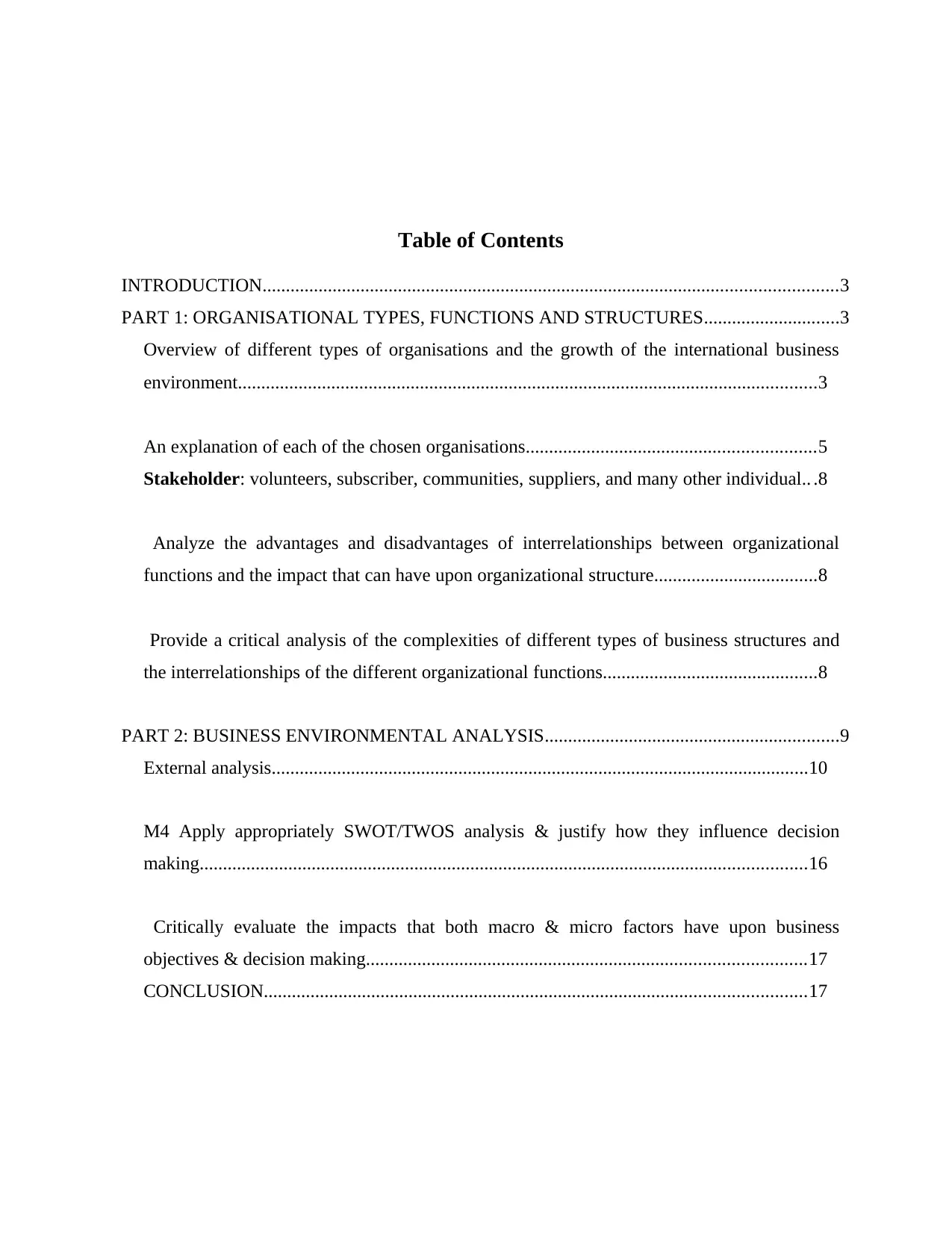
Table of Contents
INTRODUCTION...........................................................................................................................3
PART 1: ORGANISATIONAL TYPES, FUNCTIONS AND STRUCTURES.............................3
Overview of different types of organisations and the growth of the international business
environment............................................................................................................................3
An explanation of each of the chosen organisations..............................................................5
Stakeholder: volunteers, subscriber, communities, suppliers, and many other individual.. .8
Analyze the advantages and disadvantages of interrelationships between organizational
functions and the impact that can have upon organizational structure...................................8
Provide a critical analysis of the complexities of different types of business structures and
the interrelationships of the different organizational functions..............................................8
PART 2: BUSINESS ENVIRONMENTAL ANALYSIS...............................................................9
External analysis...................................................................................................................10
M4 Apply appropriately SWOT/TWOS analysis & justify how they influence decision
making..................................................................................................................................16
Critically evaluate the impacts that both macro & micro factors have upon business
objectives & decision making..............................................................................................17
CONCLUSION....................................................................................................................17
INTRODUCTION...........................................................................................................................3
PART 1: ORGANISATIONAL TYPES, FUNCTIONS AND STRUCTURES.............................3
Overview of different types of organisations and the growth of the international business
environment............................................................................................................................3
An explanation of each of the chosen organisations..............................................................5
Stakeholder: volunteers, subscriber, communities, suppliers, and many other individual.. .8
Analyze the advantages and disadvantages of interrelationships between organizational
functions and the impact that can have upon organizational structure...................................8
Provide a critical analysis of the complexities of different types of business structures and
the interrelationships of the different organizational functions..............................................8
PART 2: BUSINESS ENVIRONMENTAL ANALYSIS...............................................................9
External analysis...................................................................................................................10
M4 Apply appropriately SWOT/TWOS analysis & justify how they influence decision
making..................................................................................................................................16
Critically evaluate the impacts that both macro & micro factors have upon business
objectives & decision making..............................................................................................17
CONCLUSION....................................................................................................................17

⊘ This is a preview!⊘
Do you want full access?
Subscribe today to unlock all pages.

Trusted by 1+ million students worldwide
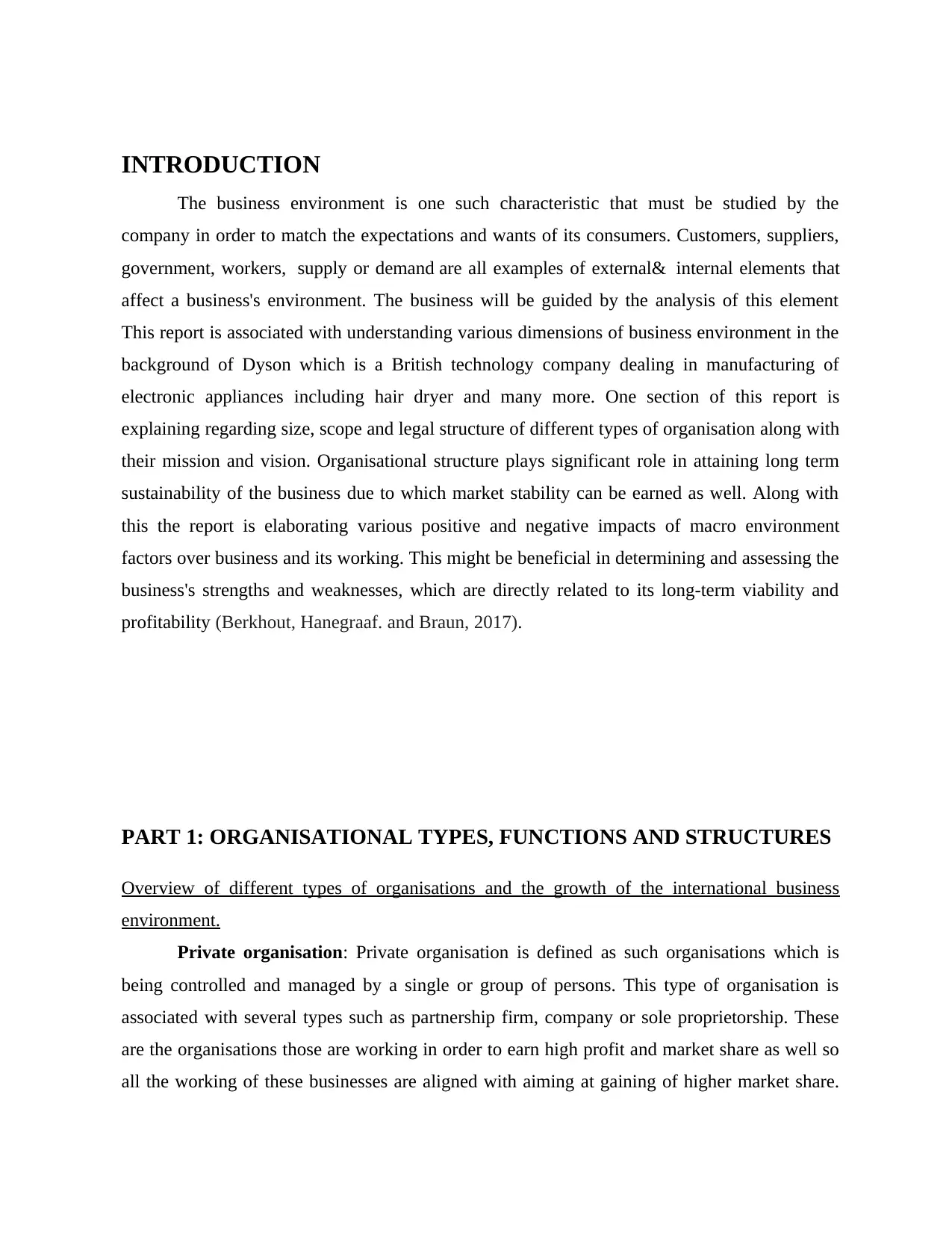
INTRODUCTION
The business environment is one such characteristic that must be studied by the
company in order to match the expectations and wants of its consumers. Customers, suppliers,
government, workers, supply or demand are all examples of external& internal elements that
affect a business's environment. The business will be guided by the analysis of this element
This report is associated with understanding various dimensions of business environment in the
background of Dyson which is a British technology company dealing in manufacturing of
electronic appliances including hair dryer and many more. One section of this report is
explaining regarding size, scope and legal structure of different types of organisation along with
their mission and vision. Organisational structure plays significant role in attaining long term
sustainability of the business due to which market stability can be earned as well. Along with
this the report is elaborating various positive and negative impacts of macro environment
factors over business and its working. This might be beneficial in determining and assessing the
business's strengths and weaknesses, which are directly related to its long-term viability and
profitability (Berkhout, Hanegraaf. and Braun, 2017).
PART 1: ORGANISATIONAL TYPES, FUNCTIONS AND STRUCTURES
Overview of different types of organisations and the growth of the international business
environment.
Private organisation: Private organisation is defined as such organisations which is
being controlled and managed by a single or group of persons. This type of organisation is
associated with several types such as partnership firm, company or sole proprietorship. These
are the organisations those are working in order to earn high profit and market share as well so
all the working of these businesses are aligned with aiming at gaining of higher market share.
The business environment is one such characteristic that must be studied by the
company in order to match the expectations and wants of its consumers. Customers, suppliers,
government, workers, supply or demand are all examples of external& internal elements that
affect a business's environment. The business will be guided by the analysis of this element
This report is associated with understanding various dimensions of business environment in the
background of Dyson which is a British technology company dealing in manufacturing of
electronic appliances including hair dryer and many more. One section of this report is
explaining regarding size, scope and legal structure of different types of organisation along with
their mission and vision. Organisational structure plays significant role in attaining long term
sustainability of the business due to which market stability can be earned as well. Along with
this the report is elaborating various positive and negative impacts of macro environment
factors over business and its working. This might be beneficial in determining and assessing the
business's strengths and weaknesses, which are directly related to its long-term viability and
profitability (Berkhout, Hanegraaf. and Braun, 2017).
PART 1: ORGANISATIONAL TYPES, FUNCTIONS AND STRUCTURES
Overview of different types of organisations and the growth of the international business
environment.
Private organisation: Private organisation is defined as such organisations which is
being controlled and managed by a single or group of persons. This type of organisation is
associated with several types such as partnership firm, company or sole proprietorship. These
are the organisations those are working in order to earn high profit and market share as well so
all the working of these businesses are aligned with aiming at gaining of higher market share.
Paraphrase This Document
Need a fresh take? Get an instant paraphrase of this document with our AI Paraphraser
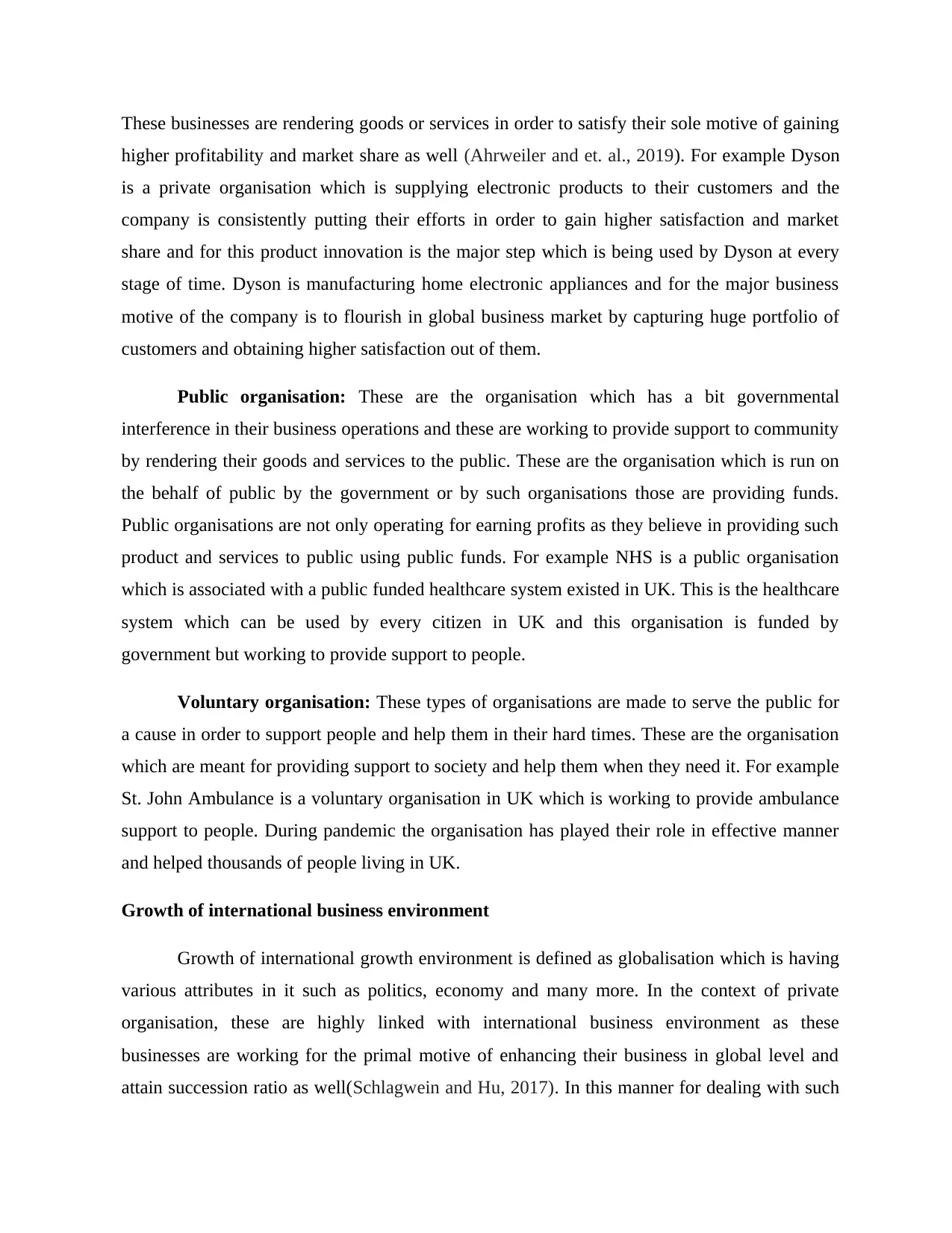
These businesses are rendering goods or services in order to satisfy their sole motive of gaining
higher profitability and market share as well (Ahrweiler and et. al., 2019). For example Dyson
is a private organisation which is supplying electronic products to their customers and the
company is consistently putting their efforts in order to gain higher satisfaction and market
share and for this product innovation is the major step which is being used by Dyson at every
stage of time. Dyson is manufacturing home electronic appliances and for the major business
motive of the company is to flourish in global business market by capturing huge portfolio of
customers and obtaining higher satisfaction out of them.
Public organisation: These are the organisation which has a bit governmental
interference in their business operations and these are working to provide support to community
by rendering their goods and services to the public. These are the organisation which is run on
the behalf of public by the government or by such organisations those are providing funds.
Public organisations are not only operating for earning profits as they believe in providing such
product and services to public using public funds. For example NHS is a public organisation
which is associated with a public funded healthcare system existed in UK. This is the healthcare
system which can be used by every citizen in UK and this organisation is funded by
government but working to provide support to people.
Voluntary organisation: These types of organisations are made to serve the public for
a cause in order to support people and help them in their hard times. These are the organisation
which are meant for providing support to society and help them when they need it. For example
St. John Ambulance is a voluntary organisation in UK which is working to provide ambulance
support to people. During pandemic the organisation has played their role in effective manner
and helped thousands of people living in UK.
Growth of international business environment
Growth of international growth environment is defined as globalisation which is having
various attributes in it such as politics, economy and many more. In the context of private
organisation, these are highly linked with international business environment as these
businesses are working for the primal motive of enhancing their business in global level and
attain succession ratio as well(Schlagwein and Hu, 2017). In this manner for dealing with such
higher profitability and market share as well (Ahrweiler and et. al., 2019). For example Dyson
is a private organisation which is supplying electronic products to their customers and the
company is consistently putting their efforts in order to gain higher satisfaction and market
share and for this product innovation is the major step which is being used by Dyson at every
stage of time. Dyson is manufacturing home electronic appliances and for the major business
motive of the company is to flourish in global business market by capturing huge portfolio of
customers and obtaining higher satisfaction out of them.
Public organisation: These are the organisation which has a bit governmental
interference in their business operations and these are working to provide support to community
by rendering their goods and services to the public. These are the organisation which is run on
the behalf of public by the government or by such organisations those are providing funds.
Public organisations are not only operating for earning profits as they believe in providing such
product and services to public using public funds. For example NHS is a public organisation
which is associated with a public funded healthcare system existed in UK. This is the healthcare
system which can be used by every citizen in UK and this organisation is funded by
government but working to provide support to people.
Voluntary organisation: These types of organisations are made to serve the public for
a cause in order to support people and help them in their hard times. These are the organisation
which are meant for providing support to society and help them when they need it. For example
St. John Ambulance is a voluntary organisation in UK which is working to provide ambulance
support to people. During pandemic the organisation has played their role in effective manner
and helped thousands of people living in UK.
Growth of international business environment
Growth of international growth environment is defined as globalisation which is having
various attributes in it such as politics, economy and many more. In the context of private
organisation, these are highly linked with international business environment as these
businesses are working for the primal motive of enhancing their business in global level and
attain succession ratio as well(Schlagwein and Hu, 2017). In this manner for dealing with such
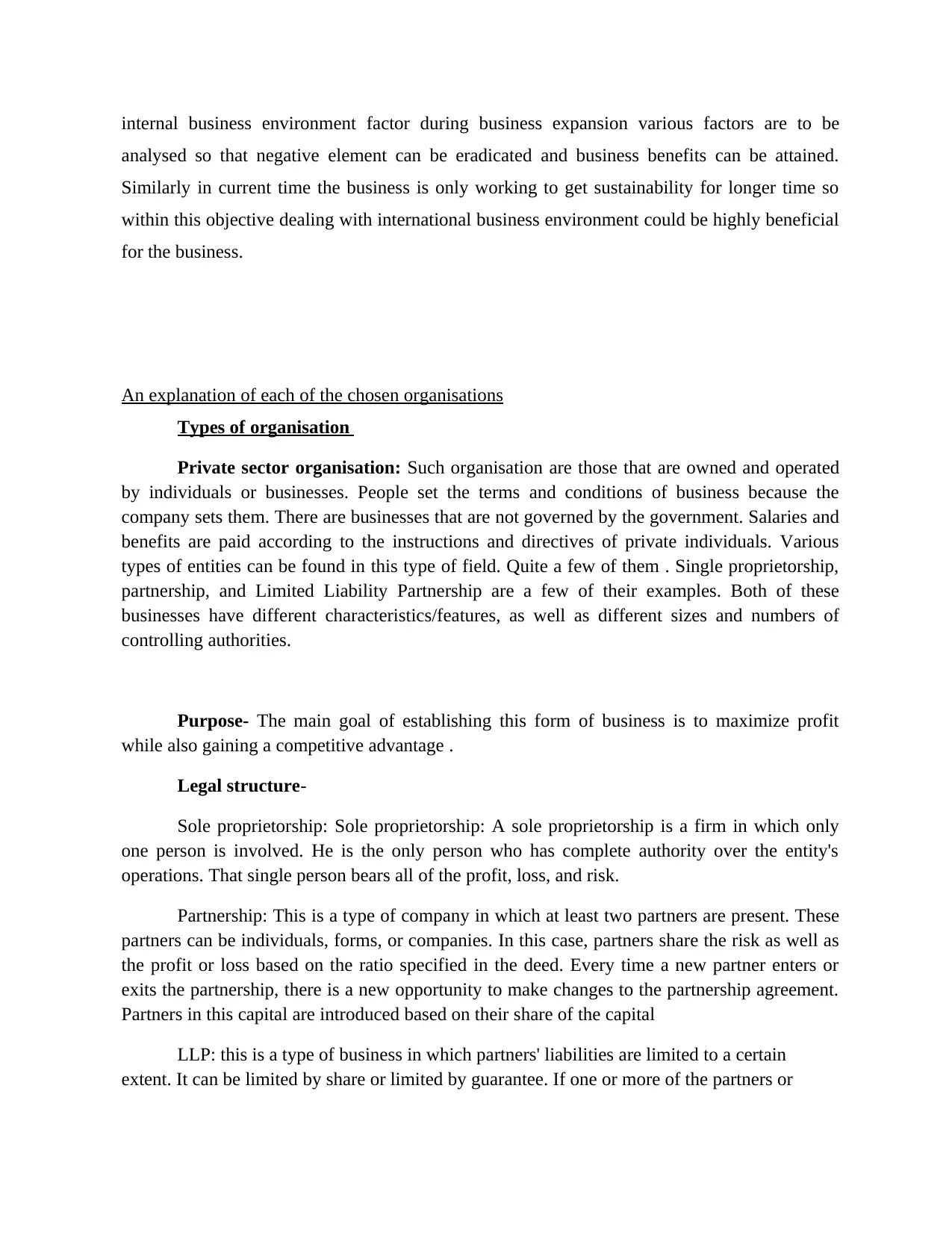
internal business environment factor during business expansion various factors are to be
analysed so that negative element can be eradicated and business benefits can be attained.
Similarly in current time the business is only working to get sustainability for longer time so
within this objective dealing with international business environment could be highly beneficial
for the business.
An explanation of each of the chosen organisations
Types of organisation
Private sector organisation: Such organisation are those that are owned and operated
by individuals or businesses. People set the terms and conditions of business because the
company sets them. There are businesses that are not governed by the government. Salaries and
benefits are paid according to the instructions and directives of private individuals. Various
types of entities can be found in this type of field. Quite a few of them . Single proprietorship,
partnership, and Limited Liability Partnership are a few of their examples. Both of these
businesses have different characteristics/features, as well as different sizes and numbers of
controlling authorities.
Purpose- The main goal of establishing this form of business is to maximize profit
while also gaining a competitive advantage .
Legal structure-
Sole proprietorship: Sole proprietorship: A sole proprietorship is a firm in which only
one person is involved. He is the only person who has complete authority over the entity's
operations. That single person bears all of the profit, loss, and risk.
Partnership: This is a type of company in which at least two partners are present. These
partners can be individuals, forms, or companies. In this case, partners share the risk as well as
the profit or loss based on the ratio specified in the deed. Every time a new partner enters or
exits the partnership, there is a new opportunity to make changes to the partnership agreement.
Partners in this capital are introduced based on their share of the capital
LLP: this is a type of business in which partners' liabilities are limited to a certain
extent. It can be limited by share or limited by guarantee. If one or more of the partners or
analysed so that negative element can be eradicated and business benefits can be attained.
Similarly in current time the business is only working to get sustainability for longer time so
within this objective dealing with international business environment could be highly beneficial
for the business.
An explanation of each of the chosen organisations
Types of organisation
Private sector organisation: Such organisation are those that are owned and operated
by individuals or businesses. People set the terms and conditions of business because the
company sets them. There are businesses that are not governed by the government. Salaries and
benefits are paid according to the instructions and directives of private individuals. Various
types of entities can be found in this type of field. Quite a few of them . Single proprietorship,
partnership, and Limited Liability Partnership are a few of their examples. Both of these
businesses have different characteristics/features, as well as different sizes and numbers of
controlling authorities.
Purpose- The main goal of establishing this form of business is to maximize profit
while also gaining a competitive advantage .
Legal structure-
Sole proprietorship: Sole proprietorship: A sole proprietorship is a firm in which only
one person is involved. He is the only person who has complete authority over the entity's
operations. That single person bears all of the profit, loss, and risk.
Partnership: This is a type of company in which at least two partners are present. These
partners can be individuals, forms, or companies. In this case, partners share the risk as well as
the profit or loss based on the ratio specified in the deed. Every time a new partner enters or
exits the partnership, there is a new opportunity to make changes to the partnership agreement.
Partners in this capital are introduced based on their share of the capital
LLP: this is a type of business in which partners' liabilities are limited to a certain
extent. It can be limited by share or limited by guarantee. If one or more of the partners or
⊘ This is a preview!⊘
Do you want full access?
Subscribe today to unlock all pages.

Trusted by 1+ million students worldwide
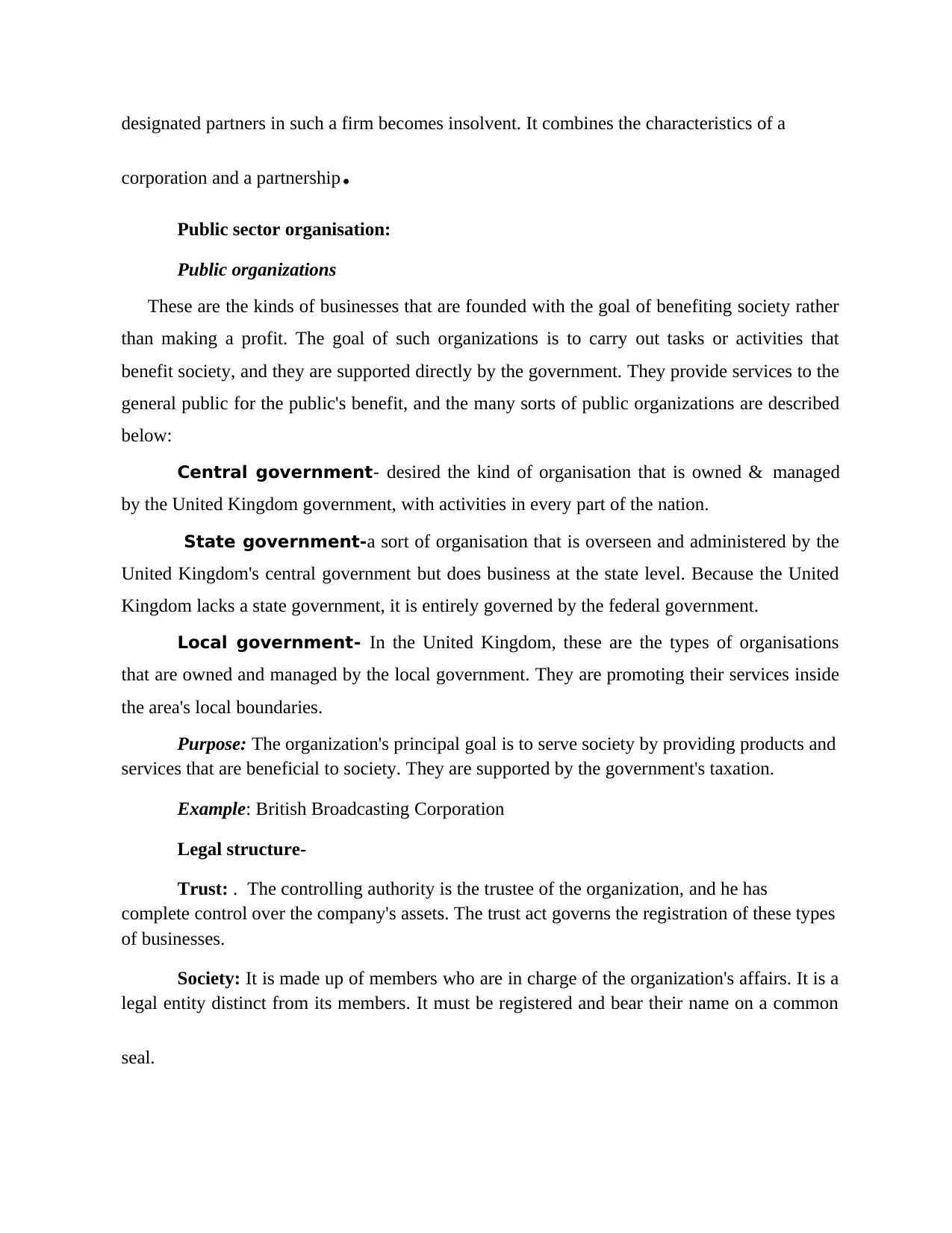
designated partners in such a firm becomes insolvent. It combines the characteristics of a
corporation and a partnership.
Public sector organisation:
Public organizations
These are the kinds of businesses that are founded with the goal of benefiting society rather
than making a profit. The goal of such organizations is to carry out tasks or activities that
benefit society, and they are supported directly by the government. They provide services to the
general public for the public's benefit, and the many sorts of public organizations are described
below:
Central government- desired the kind of organisation that is owned & managed
by the United Kingdom government, with activities in every part of the nation.
State government-a sort of organisation that is overseen and administered by the
United Kingdom's central government but does business at the state level. Because the United
Kingdom lacks a state government, it is entirely governed by the federal government.
Local government- In the United Kingdom, these are the types of organisations
that are owned and managed by the local government. They are promoting their services inside
the area's local boundaries.
Purpose: The organization's principal goal is to serve society by providing products and
services that are beneficial to society. They are supported by the government's taxation.
Example: British Broadcasting Corporation
Legal structure-
Trust: . The controlling authority is the trustee of the organization, and he has
complete control over the company's assets. The trust act governs the registration of these types
of businesses.
Society: It is made up of members who are in charge of the organization's affairs. It is a
legal entity distinct from its members. It must be registered and bear their name on a common
seal.
corporation and a partnership.
Public sector organisation:
Public organizations
These are the kinds of businesses that are founded with the goal of benefiting society rather
than making a profit. The goal of such organizations is to carry out tasks or activities that
benefit society, and they are supported directly by the government. They provide services to the
general public for the public's benefit, and the many sorts of public organizations are described
below:
Central government- desired the kind of organisation that is owned & managed
by the United Kingdom government, with activities in every part of the nation.
State government-a sort of organisation that is overseen and administered by the
United Kingdom's central government but does business at the state level. Because the United
Kingdom lacks a state government, it is entirely governed by the federal government.
Local government- In the United Kingdom, these are the types of organisations
that are owned and managed by the local government. They are promoting their services inside
the area's local boundaries.
Purpose: The organization's principal goal is to serve society by providing products and
services that are beneficial to society. They are supported by the government's taxation.
Example: British Broadcasting Corporation
Legal structure-
Trust: . The controlling authority is the trustee of the organization, and he has
complete control over the company's assets. The trust act governs the registration of these types
of businesses.
Society: It is made up of members who are in charge of the organization's affairs. It is a
legal entity distinct from its members. It must be registered and bear their name on a common
seal.
Paraphrase This Document
Need a fresh take? Get an instant paraphrase of this document with our AI Paraphraser

Not for profit making organisation:. Rather of making a profit, these organisations are
created for the goal of social welfare. These organisations get their money through donations,
charity funding, and subscription fees.
The size and scope of various types of organizations
BBC Background: It was established in 1922. Businesses and consumers with
television access contribute a significant amount of money to the brand.
products and services: through delivering national television channels such as BBC
News, BBC iplayer, BBC One, and others.
Scope: to broaden their service offerings by entering new markets such as India and
China.
Size:. BBC has a workforce of over twenty thousand people.
Mission: To gain a large customer base by entertaining the audience through their
programs.
Vision: To be the most innovative and creative company in the world.
Stakeholders: A few examples of internal and external stakeholders include the local
community, the program editor, and the local community.
Tesco
Background: It is the world's third largest retailer. It was established in 1919. Its
headquarters are in the United Kingdom
Product/services offered: It is a retailer that sells food, apparel, and electronics to the
general public. It also provides clients with online services. Tesco had space for improvement
in terms of both service delivery and technical participation.
Size: It employed approximately forty thousand people in their stores.
Scope: Customers can also use the company's internet services. Tesco had space for
improvement in terms of both service delivery and technical participation. the mission Their
created for the goal of social welfare. These organisations get their money through donations,
charity funding, and subscription fees.
The size and scope of various types of organizations
BBC Background: It was established in 1922. Businesses and consumers with
television access contribute a significant amount of money to the brand.
products and services: through delivering national television channels such as BBC
News, BBC iplayer, BBC One, and others.
Scope: to broaden their service offerings by entering new markets such as India and
China.
Size:. BBC has a workforce of over twenty thousand people.
Mission: To gain a large customer base by entertaining the audience through their
programs.
Vision: To be the most innovative and creative company in the world.
Stakeholders: A few examples of internal and external stakeholders include the local
community, the program editor, and the local community.
Tesco
Background: It is the world's third largest retailer. It was established in 1919. Its
headquarters are in the United Kingdom
Product/services offered: It is a retailer that sells food, apparel, and electronics to the
general public. It also provides clients with online services. Tesco had space for improvement
in terms of both service delivery and technical participation.
Size: It employed approximately forty thousand people in their stores.
Scope: Customers can also use the company's internet services. Tesco had space for
improvement in terms of both service delivery and technical participation. the mission Their
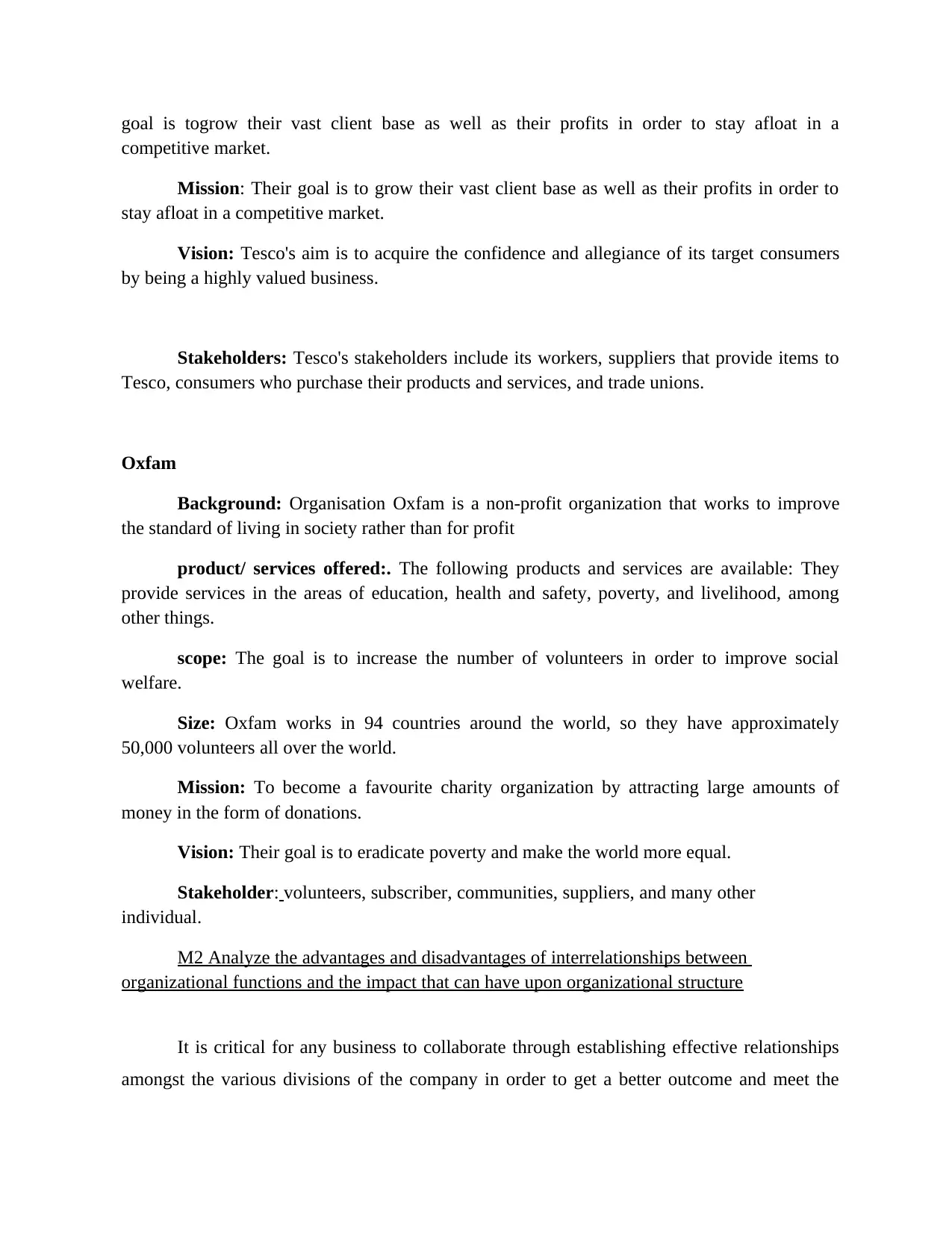
goal is togrow their vast client base as well as their profits in order to stay afloat in a
competitive market.
Mission: Their goal is to grow their vast client base as well as their profits in order to
stay afloat in a competitive market.
Vision: Tesco's aim is to acquire the confidence and allegiance of its target consumers
by being a highly valued business.
Stakeholders: Tesco's stakeholders include its workers, suppliers that provide items to
Tesco, consumers who purchase their products and services, and trade unions.
Oxfam
Background: Organisation Oxfam is a non-profit organization that works to improve
the standard of living in society rather than for profit
product/ services offered:. The following products and services are available: They
provide services in the areas of education, health and safety, poverty, and livelihood, among
other things.
scope: The goal is to increase the number of volunteers in order to improve social
welfare.
Size: Oxfam works in 94 countries around the world, so they have approximately
50,000 volunteers all over the world.
Mission: To become a favourite charity organization by attracting large amounts of
money in the form of donations.
Vision: Their goal is to eradicate poverty and make the world more equal.
Stakeholder: volunteers, subscriber, communities, suppliers, and many other
individual.
M2 Analyze the advantages and disadvantages of interrelationships between
organizational functions and the impact that can have upon organizational structure
It is critical for any business to collaborate through establishing effective relationships
amongst the various divisions of the company in order to get a better outcome and meet the
competitive market.
Mission: Their goal is to grow their vast client base as well as their profits in order to
stay afloat in a competitive market.
Vision: Tesco's aim is to acquire the confidence and allegiance of its target consumers
by being a highly valued business.
Stakeholders: Tesco's stakeholders include its workers, suppliers that provide items to
Tesco, consumers who purchase their products and services, and trade unions.
Oxfam
Background: Organisation Oxfam is a non-profit organization that works to improve
the standard of living in society rather than for profit
product/ services offered:. The following products and services are available: They
provide services in the areas of education, health and safety, poverty, and livelihood, among
other things.
scope: The goal is to increase the number of volunteers in order to improve social
welfare.
Size: Oxfam works in 94 countries around the world, so they have approximately
50,000 volunteers all over the world.
Mission: To become a favourite charity organization by attracting large amounts of
money in the form of donations.
Vision: Their goal is to eradicate poverty and make the world more equal.
Stakeholder: volunteers, subscriber, communities, suppliers, and many other
individual.
M2 Analyze the advantages and disadvantages of interrelationships between
organizational functions and the impact that can have upon organizational structure
It is critical for any business to collaborate through establishing effective relationships
amongst the various divisions of the company in order to get a better outcome and meet the
⊘ This is a preview!⊘
Do you want full access?
Subscribe today to unlock all pages.

Trusted by 1+ million students worldwide
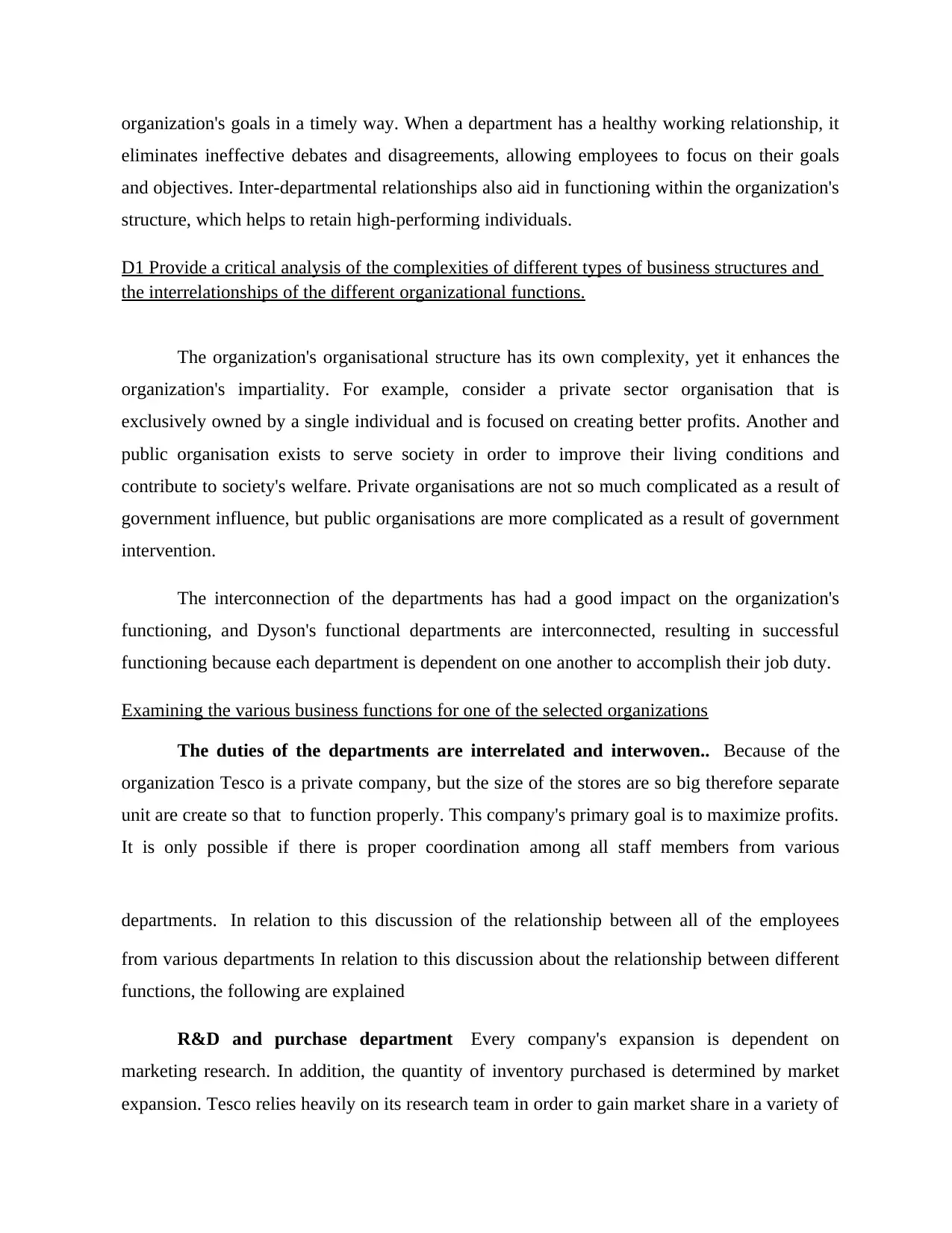
organization's goals in a timely way. When a department has a healthy working relationship, it
eliminates ineffective debates and disagreements, allowing employees to focus on their goals
and objectives. Inter-departmental relationships also aid in functioning within the organization's
structure, which helps to retain high-performing individuals.
D1 Provide a critical analysis of the complexities of different types of business structures and
the interrelationships of the different organizational functions.
The organization's organisational structure has its own complexity, yet it enhances the
organization's impartiality. For example, consider a private sector organisation that is
exclusively owned by a single individual and is focused on creating better profits. Another and
public organisation exists to serve society in order to improve their living conditions and
contribute to society's welfare. Private organisations are not so much complicated as a result of
government influence, but public organisations are more complicated as a result of government
intervention.
The interconnection of the departments has had a good impact on the organization's
functioning, and Dyson's functional departments are interconnected, resulting in successful
functioning because each department is dependent on one another to accomplish their job duty.
Examining the various business functions for one of the selected organizations
The duties of the departments are interrelated and interwoven.. Because of the
organization Tesco is a private company, but the size of the stores are so big therefore separate
unit are create so that to function properly. This company's primary goal is to maximize profits.
It is only possible if there is proper coordination among all staff members from various
departments. In relation to this discussion of the relationship between all of the employees
from various departments In relation to this discussion about the relationship between different
functions, the following are explained
R&D and purchase department Every company's expansion is dependent on
marketing research. In addition, the quantity of inventory purchased is determined by market
expansion. Tesco relies heavily on its research team in order to gain market share in a variety of
eliminates ineffective debates and disagreements, allowing employees to focus on their goals
and objectives. Inter-departmental relationships also aid in functioning within the organization's
structure, which helps to retain high-performing individuals.
D1 Provide a critical analysis of the complexities of different types of business structures and
the interrelationships of the different organizational functions.
The organization's organisational structure has its own complexity, yet it enhances the
organization's impartiality. For example, consider a private sector organisation that is
exclusively owned by a single individual and is focused on creating better profits. Another and
public organisation exists to serve society in order to improve their living conditions and
contribute to society's welfare. Private organisations are not so much complicated as a result of
government influence, but public organisations are more complicated as a result of government
intervention.
The interconnection of the departments has had a good impact on the organization's
functioning, and Dyson's functional departments are interconnected, resulting in successful
functioning because each department is dependent on one another to accomplish their job duty.
Examining the various business functions for one of the selected organizations
The duties of the departments are interrelated and interwoven.. Because of the
organization Tesco is a private company, but the size of the stores are so big therefore separate
unit are create so that to function properly. This company's primary goal is to maximize profits.
It is only possible if there is proper coordination among all staff members from various
departments. In relation to this discussion of the relationship between all of the employees
from various departments In relation to this discussion about the relationship between different
functions, the following are explained
R&D and purchase department Every company's expansion is dependent on
marketing research. In addition, the quantity of inventory purchased is determined by market
expansion. Tesco relies heavily on its research team in order to gain market share in a variety of
Paraphrase This Document
Need a fresh take? Get an instant paraphrase of this document with our AI Paraphraser
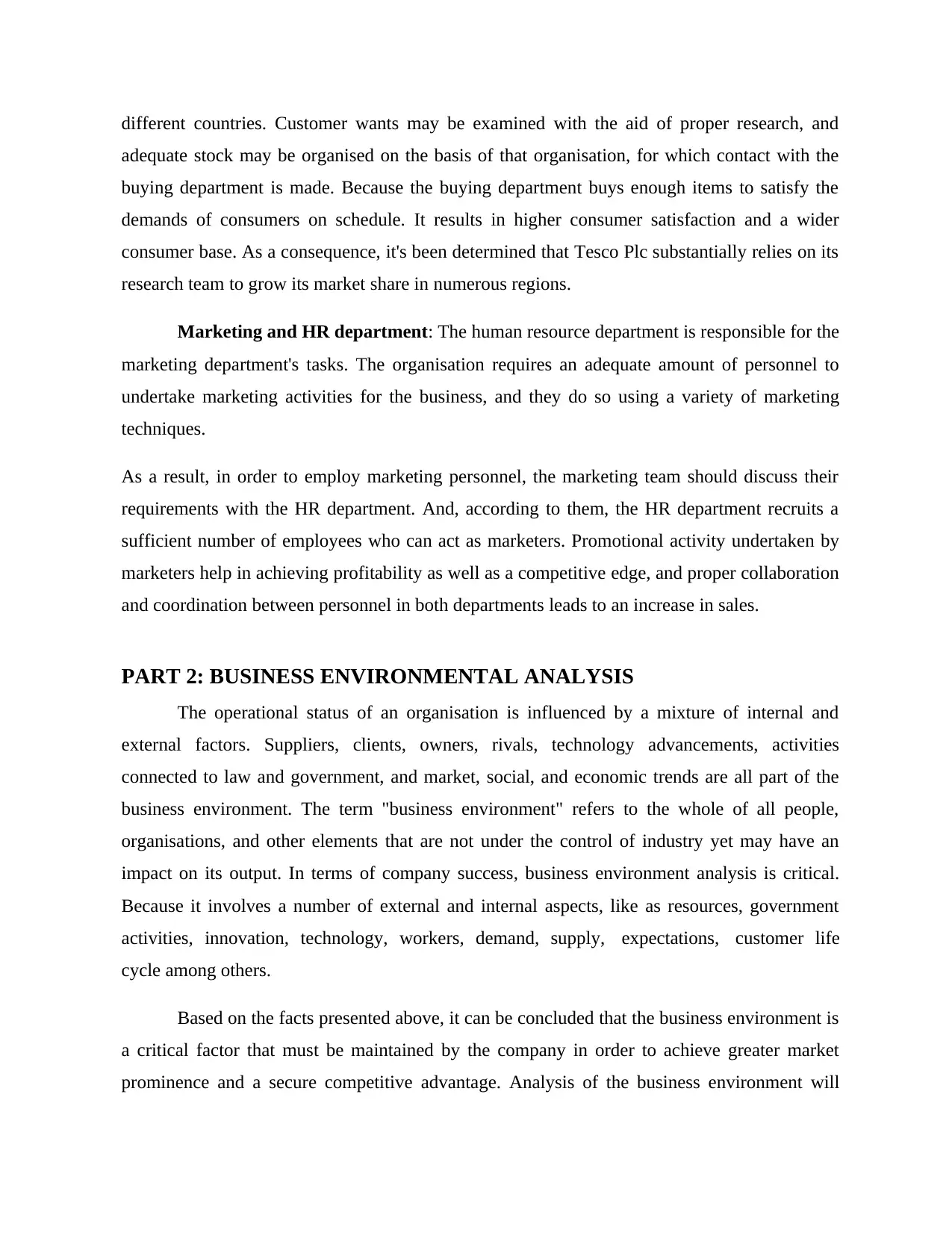
different countries. Customer wants may be examined with the aid of proper research, and
adequate stock may be organised on the basis of that organisation, for which contact with the
buying department is made. Because the buying department buys enough items to satisfy the
demands of consumers on schedule. It results in higher consumer satisfaction and a wider
consumer base. As a consequence, it's been determined that Tesco Plc substantially relies on its
research team to grow its market share in numerous regions.
Marketing and HR department: The human resource department is responsible for the
marketing department's tasks. The organisation requires an adequate amount of personnel to
undertake marketing activities for the business, and they do so using a variety of marketing
techniques.
As a result, in order to employ marketing personnel, the marketing team should discuss their
requirements with the HR department. And, according to them, the HR department recruits a
sufficient number of employees who can act as marketers. Promotional activity undertaken by
marketers help in achieving profitability as well as a competitive edge, and proper collaboration
and coordination between personnel in both departments leads to an increase in sales.
PART 2: BUSINESS ENVIRONMENTAL ANALYSIS
The operational status of an organisation is influenced by a mixture of internal and
external factors. Suppliers, clients, owners, rivals, technology advancements, activities
connected to law and government, and market, social, and economic trends are all part of the
business environment. The term "business environment" refers to the whole of all people,
organisations, and other elements that are not under the control of industry yet may have an
impact on its output. In terms of company success, business environment analysis is critical.
Because it involves a number of external and internal aspects, like as resources, government
activities, innovation, technology, workers, demand, supply, expectations, customer life
cycle among others.
Based on the facts presented above, it can be concluded that the business environment is
a critical factor that must be maintained by the company in order to achieve greater market
prominence and a secure competitive advantage. Analysis of the business environment will
adequate stock may be organised on the basis of that organisation, for which contact with the
buying department is made. Because the buying department buys enough items to satisfy the
demands of consumers on schedule. It results in higher consumer satisfaction and a wider
consumer base. As a consequence, it's been determined that Tesco Plc substantially relies on its
research team to grow its market share in numerous regions.
Marketing and HR department: The human resource department is responsible for the
marketing department's tasks. The organisation requires an adequate amount of personnel to
undertake marketing activities for the business, and they do so using a variety of marketing
techniques.
As a result, in order to employ marketing personnel, the marketing team should discuss their
requirements with the HR department. And, according to them, the HR department recruits a
sufficient number of employees who can act as marketers. Promotional activity undertaken by
marketers help in achieving profitability as well as a competitive edge, and proper collaboration
and coordination between personnel in both departments leads to an increase in sales.
PART 2: BUSINESS ENVIRONMENTAL ANALYSIS
The operational status of an organisation is influenced by a mixture of internal and
external factors. Suppliers, clients, owners, rivals, technology advancements, activities
connected to law and government, and market, social, and economic trends are all part of the
business environment. The term "business environment" refers to the whole of all people,
organisations, and other elements that are not under the control of industry yet may have an
impact on its output. In terms of company success, business environment analysis is critical.
Because it involves a number of external and internal aspects, like as resources, government
activities, innovation, technology, workers, demand, supply, expectations, customer life
cycle among others.
Based on the facts presented above, it can be concluded that the business environment is
a critical factor that must be maintained by the company in order to achieve greater market
prominence and a secure competitive advantage. Analysis of the business environment will
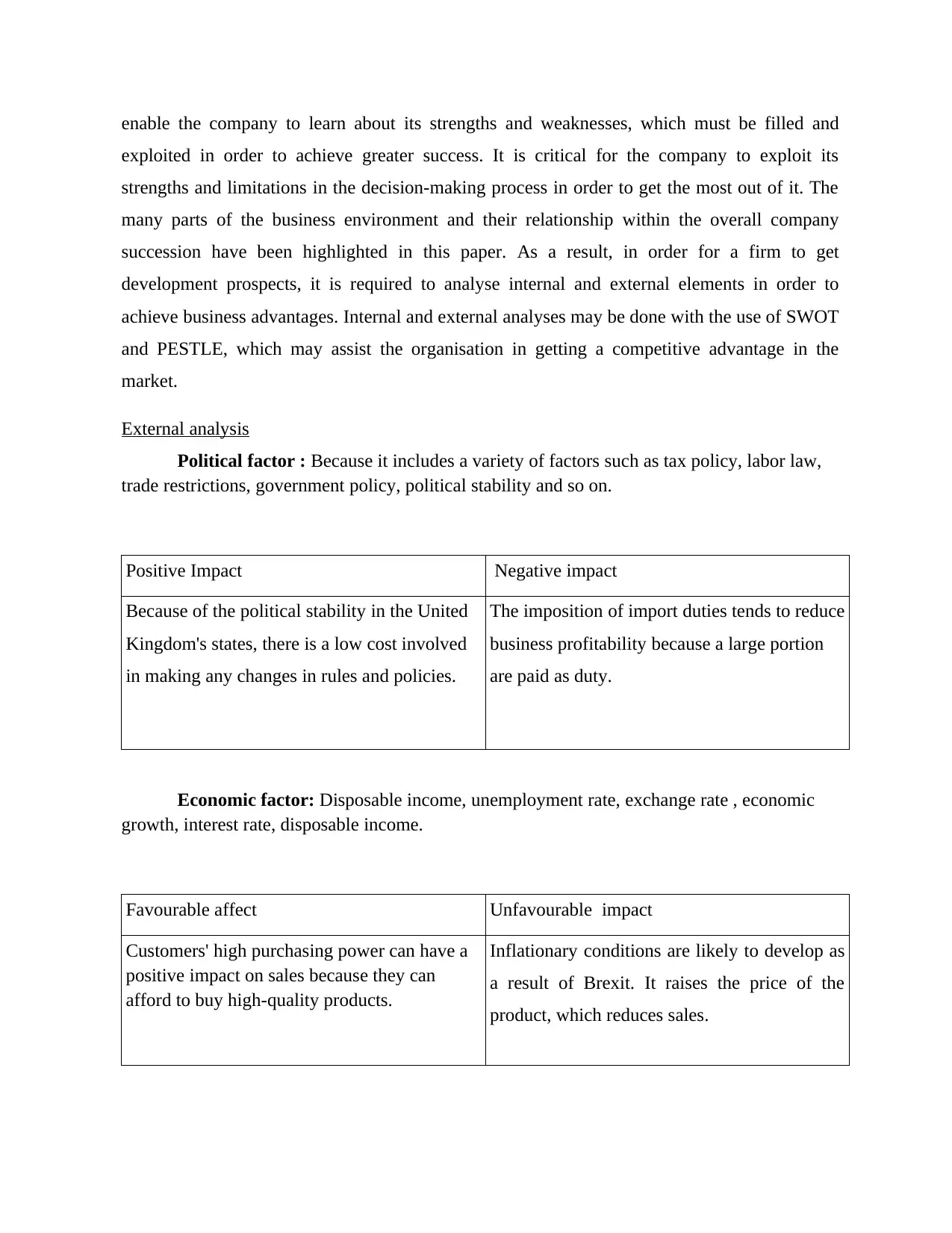
enable the company to learn about its strengths and weaknesses, which must be filled and
exploited in order to achieve greater success. It is critical for the company to exploit its
strengths and limitations in the decision-making process in order to get the most out of it. The
many parts of the business environment and their relationship within the overall company
succession have been highlighted in this paper. As a result, in order for a firm to get
development prospects, it is required to analyse internal and external elements in order to
achieve business advantages. Internal and external analyses may be done with the use of SWOT
and PESTLE, which may assist the organisation in getting a competitive advantage in the
market.
External analysis
Political factor : Because it includes a variety of factors such as tax policy, labor law,
trade restrictions, government policy, political stability and so on.
Positive Impact Negative impact
Because of the political stability in the United
Kingdom's states, there is a low cost involved
in making any changes in rules and policies.
The imposition of import duties tends to reduce
business profitability because a large portion
are paid as duty.
Economic factor: Disposable income, unemployment rate, exchange rate , economic
growth, interest rate, disposable income.
Favourable affect Unfavourable impact
Customers' high purchasing power can have a
positive impact on sales because they can
afford to buy high-quality products.
Inflationary conditions are likely to develop as
a result of Brexit. It raises the price of the
product, which reduces sales.
exploited in order to achieve greater success. It is critical for the company to exploit its
strengths and limitations in the decision-making process in order to get the most out of it. The
many parts of the business environment and their relationship within the overall company
succession have been highlighted in this paper. As a result, in order for a firm to get
development prospects, it is required to analyse internal and external elements in order to
achieve business advantages. Internal and external analyses may be done with the use of SWOT
and PESTLE, which may assist the organisation in getting a competitive advantage in the
market.
External analysis
Political factor : Because it includes a variety of factors such as tax policy, labor law,
trade restrictions, government policy, political stability and so on.
Positive Impact Negative impact
Because of the political stability in the United
Kingdom's states, there is a low cost involved
in making any changes in rules and policies.
The imposition of import duties tends to reduce
business profitability because a large portion
are paid as duty.
Economic factor: Disposable income, unemployment rate, exchange rate , economic
growth, interest rate, disposable income.
Favourable affect Unfavourable impact
Customers' high purchasing power can have a
positive impact on sales because they can
afford to buy high-quality products.
Inflationary conditions are likely to develop as
a result of Brexit. It raises the price of the
product, which reduces sales.
⊘ This is a preview!⊘
Do you want full access?
Subscribe today to unlock all pages.

Trusted by 1+ million students worldwide
1 out of 22
Related Documents
Your All-in-One AI-Powered Toolkit for Academic Success.
+13062052269
info@desklib.com
Available 24*7 on WhatsApp / Email
![[object Object]](/_next/static/media/star-bottom.7253800d.svg)
Unlock your academic potential
Copyright © 2020–2025 A2Z Services. All Rights Reserved. Developed and managed by ZUCOL.





